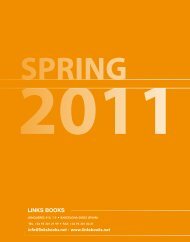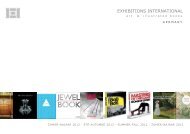pdf 1 - exhibitions international
pdf 1 - exhibitions international
pdf 1 - exhibitions international
Create successful ePaper yourself
Turn your PDF publications into a flip-book with our unique Google optimized e-Paper software.
expansion, which included a vinyl play mat printed with a town plan and roads,<br />
a series of residential and commercial buildings to put on it, and a church, plus a<br />
range of plastic cars, lorries, trees, bushes and road signs. 32<br />
The advantage for Lego, as it had been for Märklin, was that a system offered<br />
continuing sales. A system also provided a selection of items at different prices;<br />
you could use your pocket money to add a single car to your city while waiting<br />
for a kindly relative to give you a big set of bricks for your birthday. In architectural<br />
terms this Lego city of 1955 has a relatively modern appearance, which<br />
makes it look like the first of Britain’s postwar new towns, such as Stevenage with<br />
its pedestrianized city centre. 33 Scandinavian (and hence Danish) design is cited<br />
as one of the influences on the British new towns: the reason why they looked<br />
different from what had gone before, 34 and presumably the reason why they look<br />
like Lego.<br />
Moving to the twenty-first century, which has not turned out to be nearly as<br />
futuristic as we thought it would be in the 1950s, the call is now more for green<br />
cities than for new towns. The European Green City Index, a recent study of thirty<br />
cities in Europe, found that while cities were striving to be green, they were still<br />
a long way from getting there, with renewable energy contributing only 7.3% of<br />
total energy, only 20% of waste recycled, and nearly 25% of water lost through<br />
leakage. 35 The ‘greenest’ city overall was deemed to be Copenhagen, 36 whose<br />
goals include becoming the first capital city in the world to be carbon neutral by<br />
2025. 37 Lego is a proudly Danish company, so if Denmark’s capital is Europe’s<br />
greenest city, maybe Lego also follows this green trend.<br />
Lego’s Progress Report 2011, which deals with sustainability, tells how the<br />
company organized an event in Melbourne called ‘Build the Change’ in which<br />
800 Australian schoolchildren built a green city out of Lego. 38 Without being<br />
entirely specific about it, because Lego has never marketed a ‘Green City’, Lego<br />
has over the years managed to provide some of its components. The European<br />
Green City Index measures cities’ greenness in the fields of CO , Energy, Buildings,<br />
2<br />
Transport, Water, Waste and land use, Air Quality and Environmental<br />
Governance. 39 If we assume that those little Lego people (officially called<br />
‘Minifigures’) are not capable of much in the way of Environmental Governance,<br />
what does Lego offer in the other fields? How does it reproduce, on the carpet,<br />
the kinds of cities that would be desirably green in real life?<br />
Between 2008 and 2011 Lego made five sets that seem to form essential<br />
components of the green city. The first is the ‘Construction Site’ (no. 7633), in<br />
which a large mobile crane is the centrepiece of a block of low-rise mediumdensity<br />
apartments with shops on the ground floor. The flats are prefabricated in<br />
room-sized modules and the crane boom is long enough for them to be stacked<br />
up to four storeys high, but not higher, so the Lego Minifigures can walk up and<br />
don’t need a lift. This one is perhaps a bit hard to describe as particularly green,<br />
but medium-density housing often figures in proposals for greener development<br />
– for example, it forms part of the Green Party of New Zealand’s housing policy<br />
in an attempt to improve public transport access and avoid urban sprawl. 40 The<br />
next, undeniably green, set, released in 2009, is called ‘Wind Turbine Transport’<br />
(no. 7747). It makes a large-scale wind turbine to power the green city and a<br />
truck and trailer to transport it from the factory to the site where it is to be put<br />
up (perhaps with the aid of the previous year’s crane?). The year 2010 produced<br />
the apotheosis of urban sustainability, the ‘Public Transport Station’ (no. 8404),<br />
a set that includes not only a bus and a tram, but also a street-sweeping vehicle,<br />
a bus/tram interchange station, a bus or tram stop with cycle rack and bike, a<br />
kiosk for buying postcards, a couple of recycling bins and a sports car – this last<br />
is not very green but maybe it is a hybrid, and we have to hope that the bus is<br />
bio-diesel or battery-powered. Also in 2010, there was the ‘City House’, a threestorey<br />
residence using the same prefabricated elements as the original apartments,<br />
but designed as a town house, and with the inclusion of a small photovoltaic<br />
panel on the roof. There is another Lego set of a house with a solar panel on the<br />
roof, the ‘Hillside House’ (no. 5771), introduced in 2011, but it is not part of the<br />
City range. Lego, in these five sets, have covered CO and Energy, with the wind<br />
2<br />
turbine set, Transport, Waste and maybe Air Quality with the public transport<br />
set, and Buildings with the Construction Site, City House and Hillside House.<br />
In the real material world, Lego is made from acrylonitrile butadiene<br />
styrene plastic (ABS), which is made from oil and natural gas. 41 In 2011 Lego<br />
used 49,000 tonnes of plastic, which is actually relatively little material. 42 It takes<br />
the equivalent of 2 kilograms (4½ lbs) of oil to make 1 kilogram (2¼ lbs) of<br />
ABS, 43 so the manufacture of Lego currently uses roughly 100,000 tonnes of oil<br />
a year. A typical Lego set from the ones listed above to form the green city weighs<br />
less than 2 kilograms, so the whole green city in Lego would represent less than<br />
20 kilograms (44 lbs) of oil equivalent. In measurements of energy consumption,<br />
a kilogram of oil equivalent represents roughly 42MJ. 44 An average car will use<br />
around 3MJ per kilometre ( 2 ⁄3 mile) over its lifetime45 so the Lego green city<br />
would represent 840MJ or 280 kilometres (174 miles) of driving. This is probably<br />
184 Lego and the Green City Lego and the Green City 185


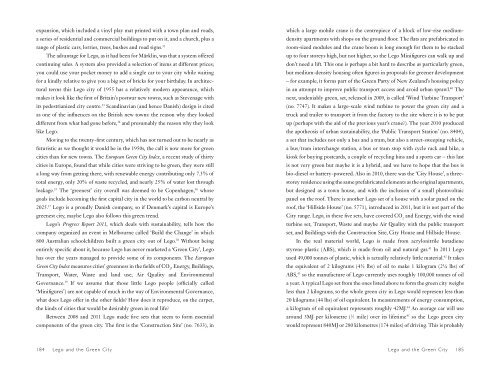

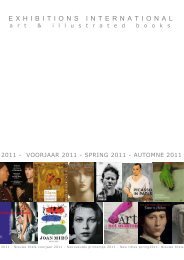

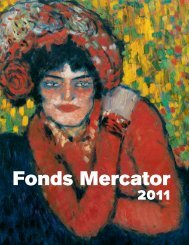



![01 -[BE/INT-2] 2 KOL +UITGEV+ - exhibitions international](https://img.yumpu.com/19621858/1/184x260/01-be-int-2-2-kol-uitgev-exhibitions-international.jpg?quality=85)




